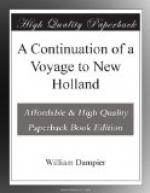Its land animals.
The land animals are buffaloes, beeves, horses, hogs, goats, sheep, monkeys, iguanas, lizards, snakes, scorpions, centumpees, etc. Beside the tame hogs and buffaloes, there are many wild all over the country, which any may freely kill. As for the beeves, horses, goats, and sheep, it is probable they were brought in by the Portuguese or Dutch; especially the beeves; for I saw none but at the Dutch fort Concordia.
We also saw monkeys and some snakes. One sort yellow, and as big as a man’s arm, and about 4 foot long: another sort no bigger than the stem of a tobacco pipe, about 5 foot long, green all over his body, and with a flat red head as big as a man’s thumb.
Fowls. The ringing-bird.
The fowls are wild cocks and hens, eagles, hawks, crows, 2 sorts of pigeons, turtledoves, 3 or 4 sorts of parrots, parakeets, cockatoos, blackbirds; besides a multitude of smaller birds of divers colours, whose charming music makes the woods very pleasant. One sort of these pretty little birds my men called the ringing-bird; because it had 6 notes, and always repeated all his notes twice one after another; beginning high and shrill and ending low. This bird was about the bigness of a lark, having a small sharp black bill and blue wings; the head and breast were of a pale red, and there was a blue streak about its neck. Here are also sea- or waterfowls, as men-of-war-birds, boobies, fishing-hawks, herons, galdens, crab-catchers, etc. The tame fowl are cocks, hens, ducks, geese; the 2 last sorts I only saw at the Dutch fort, of the other sort there are not many but among the Portuguese: the woods abound with bees, which make much honey and wax.
Its fish. Cockle merchants and oysters. Cockles as big as A man’s head.
The sea is very well stocked with fish of divers sorts, namely mullet, bass, bream, snook, mackerel, parracoots, garfish, ten-pounders, scuttle-fish, stingrays, whiprays, rasperages, cockle-merchants, or oyster-crackers, cavallies, conger-eels, rock-fish, dog-fish, etc. The rays are so plentiful that I never drew the seine but I caught some of them; which we salted and dried. I caught one whose tail was 13 foot long. The cockle-merchants are shaped like cavallies, and about their bigness. They feed on shellfish, having 2 very hard, thick, flat bones in their throat, with which they break in pieces the shells of the fish they swallow. We always find a great many shells in their maws, crushed in pieces. The shellfish are oysters of 3 sorts, namely long-oysters, common oysters, growing upon rocks in great abundance and very flat; and another sort of large oysters, fat and crooked; the shell of this not easily to be distinguished from a stone. Three or four of these roasted will suffice a man for one meal. Cockles, as big as a man’s head; of which 2 or 3 are enough for a meal; they are very fat and sweet. Crawfish, shrimps, etc. Here are also many green-turtle, some alligators and grandpisces, etc.




